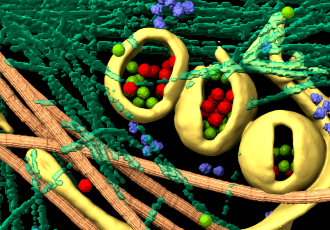11. Nov. 2024
A team of scientists from CEITEC Masaryk University, led by Pavel Plevka, has discovered a mechanism by which enteroviruses from the family Picornaviridae enter cells. The study's findings describe the process by which viruses responsible for common colds, encephalitis, or polio exploit natural cellular mechanisms to infect cells. Understanding how enteroviruses invade cells opens up opportunities for developing drugs blocking the infection.
Enteroviruses typically enter the body through the respiratory or digestive tract. Once inside, the virus binds to cell surface receptors, proteins in the cell membrane that normally enable the cell to interact with its environment.
After the virus attachment, these receptors send signals to the cell prompting it to engulf the virus within a membrane, forming a vesicle called an endosome, and absorb it. This process, known as endocytosis, by which the cell takes in substances (such as nutrients) from its surroundings, enables the virus to bypass the protective function of the cell membrane. The researchers have shown that once inside the cell, the endosomal membrane is disrupted, allowing the virus to enter the cytoplasm, where it utilises cellular resources to produce virus progeny.
“Previous theories proposed that enteroviruses would form specific structures to deliver their genomes across endosomal membranes. Our new research reveals that enteroviruses escape endosomes via the cell's natural membrane remodelling and rupture mechanisms” says co-author of the study Aygul Ishemgulova.
"Thanks to cryo-electron microscopy imaging, we were able to observe how enteroviruses make use of the endosome disruption to enter the cytoplasm," says the article co-author Zuzana Trebichalská. "The involvement of cellular mechanisms in the infection process was not surprising, as viruses typically hijack cellular compartments for their needs. However, the observation of endosome rupture during the infection process was unexpected. The results of our research may contribute to a better understanding of the biological processes in both healthy and infected cells in the future" adds another co-author Liya Mukhamedova.
The research results of Pavel Plevka's team, published in Communications Biology, represent a crucial step towards understanding the fundamental processes that enable enterovirus infection, opening new perspectives for studying endocytosis and cell entry of other non-enveloped viruses.
The research was supported by the National Institute of Virology and Bacteriology.


 Share
Share



